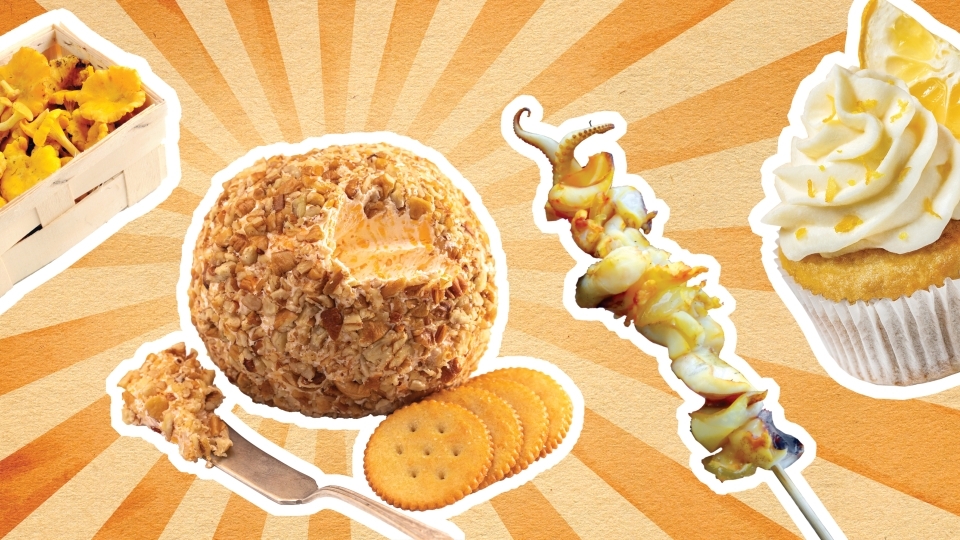Nosh & Nostalgia: Davidsonians Share Favorite Food Memories
June 28, 2024

The aroma of cake baking in the oven triggers memories of a birthday celebration from decades ago and family gathered around a table sharing dessert and laughter. How does this happen? How does the sense of smell transport us back in time?
The human brain links smell with memory. Odor molecules enter the nostrils and hit the olfactory bulb, which sends the information to the brain’s limbic system, where the amygdala and hippocampus play a vital role in emotion and memory. Chewing food releases molecules that reach a thin layer of cells lining the nasal cavities. At that moment, taste and smell work together to create flavor. But smell, the sense most connected to memory, does the heavier lifting. Without smell, the nuance of flavor would be lost: vanilla and chocolate cake would taste the same—sweet.
Food can send us hurtling into the past or into other time zones like few other sensory provocations. We asked Davidsonians to share favorite food memories from campus and abroad. Their answers may bring you back to a familiar place on campus, or to a distant corner of the world, or perhaps they’ll prompt you to rush to the local farmer’s market.
Peaches, anyone?
On Campus
In the beautiful thread of my Davidson College memories, there’s a special spot reserved for the matcha latte from Nummit. This simple drink has become more than just a beverage; it is a constant companion throughout my college days. It was beside me in the cozy corners of Nummit, where friends gathered and conversations flowed, adding warmth to the atmosphere. It was beside me when I was having piles of assignments to complete, providing a much-needed boost and motivating me to keep trying. And sometimes, the barista would doodle a smiley face next to my name on the cup, adding extra brightness to my day.
When the staff call my name, signaling my matcha is ready, I know that happiness awaits. And many years ahead, whenever I taste a matcha latte, I will remember the people I met, the emotions I experienced, and the wonderful shared moments over the cup I had at Davidson.
—Trang Dang ’27
Before I mention my favorite foods on campus, I should mention that I have many fond memories of the good people who provided and served me with excellent meals while I was on campus. I am grateful they were in my life during my time at Davidson.
When Vail Commons opened in the early ’80s, I was thrilled they had a self-service salad bar. If they were serving an entrée that I did not particularly care for, the salad bar was a great backup.
However, my all-time Davidson favorite was the Wildcat Special burger they made in the Union Cafe (located where the present day Sloan Music Center is). It was a double-decked burger topped with lettuce, tomato, cheese and tartar sauce–much better than a Big Mac. I often grabbed one for a late night snack.
—Skip Brown ’83
Your question had me reminiscing about food at Rusk House. I never missed chili and cornbread night as the cornbread really just tasted like yellow cake—so good!
—Leslie Carbone Murphy ’00
I immediately thought of Commons granola. It's been almost 14 years since I last ate on campus, but that thought immediately came back to me. Many students asked for the recipe, but I don't know if it was ever shared. A staple of my experience, for sure.
—Elinor Landess ’10
One of my favorite foods on campus is the avocado toast at Nummit. While studying, I often reward myself with something to snack on, and the light, perfectly seasoned avocado toast is my favorite pick-me-up! It is always something I can recommend to my friends or family and is just an overall yummy food that I have grown to love at Davidson!
—Ana Palomino ’27
While everyone seemed to have a different favorite among the rotation of breakfast potatoes, potato cubes were my top choice. Going into Commons in the morning and being pleasantly surprised with your favorite breakfast potato could really turn around a day that seemed to start a little too early after too little sleep. This may sound like an exaggeration, but I mean it. And if we’re going with any foods outside of Commons, the Union cookies and chicken quesadillas saved many a night!
—Mackenzie Nolan ’17
In The World
My favorite food memory goes back to when I lived in Australia as a child. Over the weekends, I often went to a mall in Perth called Carousel with my parents. Because Perth is on Australia's western coast, it's known for having an abundance of seafood. Whenever we were about to leave, we passed by a stall that sold octopus on a stick and Chinese crab claws. It’s been a long time since I had them, so I can’t exactly describe how they tasted, but they were by far the best foods I ate while living in Australia and are one of the main things I miss about it.
—Kwasi Buansi ’27
One of my favorite things to eat in Germany, or Central Europe more broadly, are Pfifferlinge (chanterelles), called Eierschwammerl in Austria, which come to market for a few months each year, mainly July and August, depending on the rain. They show up in baskets at farmer’s markets and take over restaurant menus, poached in cream, done in a soup with a white wine base, or simply sautéed with some Bärlauch (ramps) and served with parsley potatoes or over noodles.
—Scott Denham, Dana Professor of German Studies
A new food I have come across while in Tunisia is brick. Brick is a traditional Tunisian food that holds a special place in the hearts and homes of Tunisians. It is a thin pastry filled with an array of ingredients, like eggs, meat, fish and cheese. It is a staple food often enjoyed during iftar, the breaking of Ramadan's fast at sundown.
My first encounter with brick was during my program’s weekly cooking immersion session. Every Tuesday, under the guidance of our amazing program director and dedicated staff, we work together to cook a traditional Tunisian meal that we then enjoy together.
Brick has quickly become my favorite food among the variety of Tunisian dishes I’ve had the pleasure of eating, and I look forward to eating it every iftar.
—Miles Charles ’25
One of my favorite breakfast foods is “shāo ěrkuāi” 랒욥, which is a very popular street food sold by vendors in Yunnan Province in southwest China. Ěrkuāi is a thin, flat, round rice cake made entirely out of refined white rice. The rice is washed twice, soaked in cold spring water, steamed twice, and then placed in a stone mortar and pounded with a wooden pestle until it becomes soft and gummy. Finally, it is kneaded on a wooden board and shaped into a thin, flat, pancake shape. Street vendors in Yunnan Province barbecue ěrkuǎi over open-air grills. They then cover the flat rice cake with a thin layer of savory peanut sauce and spicy fermented bean curd, which is called rǔfǔ 흗릭. Lastly, they roll the ěrkuāi around a strip of deep-fried dough, called yóutiáo 答係, and serve it steaming hot. The final rolled-up breakfast snack resembles a small burrito. I have spent many early summer mornings strolling around Green Lake Park, a large public park in Kunming, the capital of Yunnan Province, while enjoying a piping hot cup of soy milk and a delicious rolled-up shāo ěrkuāi.
—Dáša Mortensen, Assistant Professor of History
Pizza—it’s simple but also complex. It has a different meaning depending on which part of the country, or world, you come from:
Chicago deep dish: My two favorites are Giordano's and Lou Malnati's. If I could combine them, it would be a perfect pie. The meat and sauce on the Giordano and the crust and cheese from Lou Malnati's.
Alino’s Pizza in Mooresville, North Carolina, is awesome. It’s cooked in a wood-fired oven in 90 seconds, and all of the ingredients are imported from Italy. The oven was built in Naples, Italy.
Detroit-style pizza: This is a pan pizza that is a rectangle with a lacy crisp cheese crust around the sides. Jet's Pizza is the best Detroit pizza chain.
New York-style: It’s hand-tossed, thin crust pizza that many consumers fold. Cut in wide wedges.
New Haven-style: This one is cooked in a coal-fired oven. Popular in New Haven, Connecticut, locally called “apizza.” Crust is charred on the outside, tomato sauce and pecorino romano cheese. Neopolitan style–a little dryer, not as saucy.
—Craig Mombert, Executive Chef
My favorite dish in Syria is Yabraq (or Dolma), which is grape leaves stuffed with minced lamb meat, boiled rice and lemon juice. They are placed in a pot and cooked slowly for a couple hours and then served hot or cold with yogurt and bread. I love this dish not just because it is so tasty, but because it is a really fun meal to prepare with friends. I have many memories in Syria of friends coming over and us just sitting and talking and stuffing our grape leaves and then sharing a meal together. In Syria, there is an expression—we have had bread and salt together so we will always be friends—and it indicates that once we’ve shared a meal together we will always stand by each other. This Syrian dish really describes this feeling for me since we are not only sharing a meal together but preparing it and socializing with our friends and family at the same time.
—Rebecca Joubin , Chair & Professor of Arab Studies
I love Taiwanese breakfast. A lot of visitors have a hard time getting used to it, but I could eat Taiwanese breakfast every day. None of it is sweet, but it’s full of delicious savory flavors and fun textures.
This picture is youtiao and luobogao (oil sticks and turnip cake). They go great with doujiang (soy milk), which can be sweet if you want.
—Shelley Rigger, Vice President for Academic Affairs & Dean of Faculty
I go for melitzanosalata (Greek: “eggplant salad”) every time I visit Greece, if not at every meal. In fact, I enjoyed some melitzanosalata in Athens during spring break. It’s smoky, salty, bright when made right, and perfect on pita or fresh bread (psomí)!
—Keyne Cheshire, Joel O. Conarroe Professor of Classics
Of all the places I get to travel for Davidson College, Korea is my favorite for its food culture. The variety of side dishes (banchan) brings the meal to life. Everything is shared, most things fermented, and chopsticks metal.
—Kaye-Lani Laughna, Director of International Admission & Financial Aid
In the summer of 2018, I worked part-time at my alma mater’s research fruit farm. I was a fresh grad and couldn’t wait to experience a summer filled with peaches that were “drip-down-your-arm good,” according to Jeff, the farm manager. Jeff had just hired me on as a farmhand to maintain and harvest from the farm’s 200-plus acres of peaches, nectarines, apricots, plums, blackberries, apples, blueberries, muscadines and other fruits. At first, the job was primarily moving mulch from one pile to another, performing minor repairs to irrigation, and learning the ins and outs of operating machinery. But as the summer days grew longer and warmer, the peaches began a dramatic transformation from tiny, yellow tennis balls to softball-sized fruit colored in different blends of red, orange and yellow. The mature fruits were visible in the carefully sculpted trees throughout the orchard—beautiful. I arrived at the farm just after sunrise every morning to pick peaches with my coworkers in the inescapable South Carolina heat. My tennis shoes squelched along in the dewy grass as we picked and picked for the first several hours of our shifts. A ripe peach is just the right amount of round, the right shade of scarlet, and the right amount of firm. Often, we would stumble across the Perfect Peach: too ripe to send to market, tree-ripe. The fruit would burst under the weight of the other peaches, or rot in the time it took for the market truck to arrive. My coworkers and I would share our Perfect Peach discoveries with each other, “oo-ing” and “ahh-ing” like we’d struck gold. My favorite fruit that summer was a variety of nectarine called June Princess. This particular nectarine was consistently “drip-down-your-arm good.” We couldn’t get enough of them when it was harvest time. One bite was filled with an ideal balance of sweet and tart. The skin was inoffensive, and the yellow flesh was soft, but not overly soft. I think about the June Princess nectarines every summer.
—Halle Murphy, Farm Manager, The Farm at Davidson

This article was originally published in the Spring/Summer 2024 print issue of the Davidson Journal Magazine; for more, please see the Davidson Journal section of our website.



